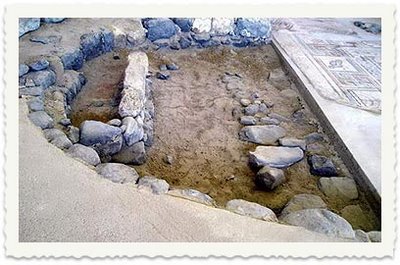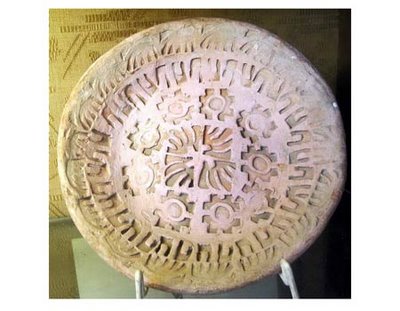Nadav Man, Bitmuna
Published: 09.30.06
Work to build army post uncovers impressive tile floor, leading to a discovery of a third-century synagogue and town near Maoz Haim (below, in 1943. The kibbutz was founded in 1937, in the Beit-Shean Valley close to the Jordanian border. Huh? Prior to the creation of the State of Israel - apparently, contrary to popular belief, Jews had established a presence prior to 1948. Good grief! Where is the public outcry? Where are the protesting dispossessed Arabs?)

As a matter of fact, these emerging settlements were comin g under constant attack from marauding Arab gangs, that is why the inhabitants were to keep watch at all times. Thus the watch towers of Maoz Haim (to the right) and Hanita (below, 1938). These kibbutzim were founded during the British Mandate, by "sabras" Israeli-born Jews (Good grief, once again, wot? not all Jewish residents got here AFTER 1948? Well, apparently NOT). Anyways, this campaign took place between 1936-1939 and was known under the name of Stockade and Tower, and it was carried out by the Hamahanot Haolim movement, a youth movement founded in 1926 - a bit of a headache there for anti-Zionists claiming there was no significant Jewish activity prior to the Declaration of Independence.
g under constant attack from marauding Arab gangs, that is why the inhabitants were to keep watch at all times. Thus the watch towers of Maoz Haim (to the right) and Hanita (below, 1938). These kibbutzim were founded during the British Mandate, by "sabras" Israeli-born Jews (Good grief, once again, wot? not all Jewish residents got here AFTER 1948? Well, apparently NOT). Anyways, this campaign took place between 1936-1939 and was known under the name of Stockade and Tower, and it was carried out by the Hamahanot Haolim movement, a youth movement founded in 1926 - a bit of a headache there for anti-Zionists claiming there was no significant Jewish activity prior to the Declaration of Independence.
 The secrets of an ancient synagogue, dating from around the 3rd to 6th century CE, were discovered completely by accident near Kibbutz Maoz Haim. In 1974, during construction work on an army post west of the kibbutz, Avshalom Yaakovi (right, undated picture), a founder of the kibbutz and specialist on the Land of Israel, discerned a mosaic floor, partly buried under the dirt, depicting what looked to him like a menora (traditional Jewish candelabra).
The secrets of an ancient synagogue, dating from around the 3rd to 6th century CE, were discovered completely by accident near Kibbutz Maoz Haim. In 1974, during construction work on an army post west of the kibbutz, Avshalom Yaakovi (right, undated picture), a founder of the kibbutz and specialist on the Land of Israel, discerned a mosaic floor, partly buried under the dirt, depicting what looked to him like a menora (traditional Jewish candelabra). Such as the one appearing on the Arch of Titus, in Rome, Italy. Was this Roman Emperor a Zionist conspirator as well?
Such as the one appearing on the Arch of Titus, in Rome, Italy. Was this Roman Emperor a Zionist conspirator as well? The seven-branched candelabra was but a fraction of the exquisite mosaic floor exposed by Avshalom who used his hands literally to remove the soil and dirt covering the find. Construction work was stopped, and the Antiquities Authority arrived at the kibbutz. Excavations uncoverd an ancient synagogue.
The seven-branched candelabra was but a fraction of the exquisite mosaic floor exposed by Avshalom who used his hands literally to remove the soil and dirt covering the find. Construction work was stopped, and the Antiquities Authority arrived at the kibbutz. Excavations uncoverd an ancient synagogue. Underneath a the remains of a Bedouin cemetery, built on the ruins of an old Arab village, a Jewish town from the third century was found. The synagogue, constructed during the latter part of the century, served the Jewish community there for over 300 years, and was destroyed, along with the rest of the the town, in a large fire which broke out during the Arab occupation of the land. According to signs found in the area, the Jewish town was called Bala, and the Bedouins too kept that name.
Underneath a the remains of a Bedouin cemetery, built on the ruins of an old Arab village, a Jewish town from the third century was found. The synagogue, constructed during the latter part of the century, served the Jewish community there for over 300 years, and was destroyed, along with the rest of the the town, in a large fire which broke out during the Arab occupation of the land. According to signs found in the area, the Jewish town was called Bala, and the Bedouins too kept that name. 







Credit should also be given to this 19th century New York Apollo watering can (detail, below) presented to Asvhalom by a worker of the Yaffo Stein Company that operated in Eretz Israel prior to World War One. It was one of the tools used by Avshalom to hand-dig the site.
 Also found at the dig: part of the tiled roof
Also found at the dig: part of the tiled roof and this elaborately crafted object:
and this elaborately crafted object:







